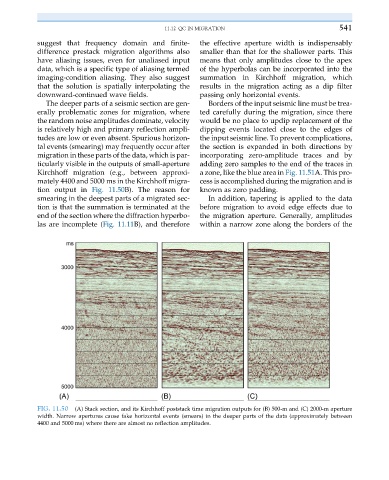Page 550 - Acquisition and Processing of Marine Seismic Data
P. 550
11.12 QC IN MIGRATION 541
suggest that frequency domain and finite- the effective aperture width is indispensably
difference prestack migration algorithms also smaller than that for the shallower parts. This
have aliasing issues, even for unaliased input means that only amplitudes close to the apex
data, which is a specific type of aliasing termed of the hyperbolas can be incorporated into the
imaging-condition aliasing. They also suggest summation in Kirchhoff migration, which
that the solution is spatially interpolating the results in the migration acting as a dip filter
downward-continued wave fields. passing only horizontal events.
The deeper parts of a seismic section are gen- Borders of the input seismic line must be trea-
erally problematic zones for migration, where ted carefully during the migration, since there
the random noise amplitudes dominate, velocity would be no place to updip replacement of the
is relatively high and primary reflection ampli- dipping events located close to the edges of
tudes are low or even absent. Spurious horizon- the input seismic line. To prevent complications,
tal events (smearing) may frequently occur after the section is expanded in both directions by
migration in these parts of the data, which is par- incorporating zero-amplitude traces and by
ticularly visible in the outputs of small-aperture adding zero samples to the end of the traces in
Kirchhoff migration (e.g., between approxi- a zone, like the blue area in Fig. 11.51A. This pro-
mately 4400 and 5000 ms in the Kirchhoff migra- cess is accomplished during the migration and is
tion output in Fig. 11.50B). The reason for known as zero padding.
smearing in the deepest parts of a migrated sec- In addition, tapering is applied to the data
tion is that the summation is terminated at the before migration to avoid edge effects due to
end of the section where the diffraction hyperbo- the migration aperture. Generally, amplitudes
las are incomplete (Fig. 11.11B), and therefore within a narrow zone along the borders of the
FIG. 11.50 (A) Stack section, and its Kirchhoff poststack time migration outputs for (B) 500-m and (C) 2000-m aperture
width. Narrow apertures cause fake horizontal events (smears) in the deeper parts of the data (approximately between
4400 and 5000 ms) where there are almost no reflection amplitudes.

